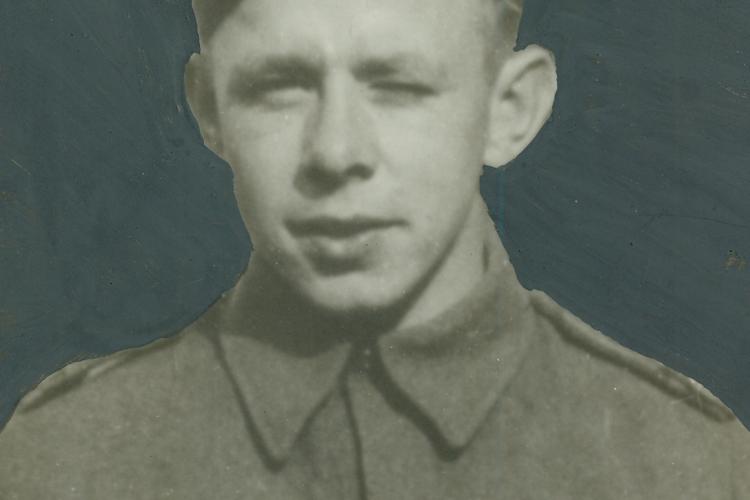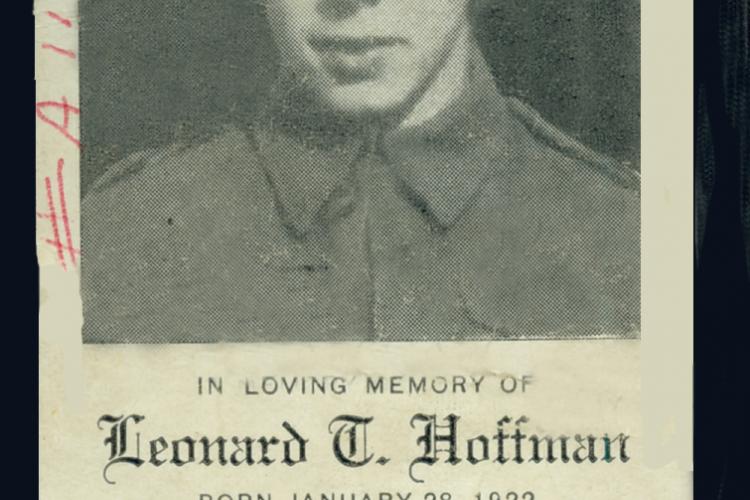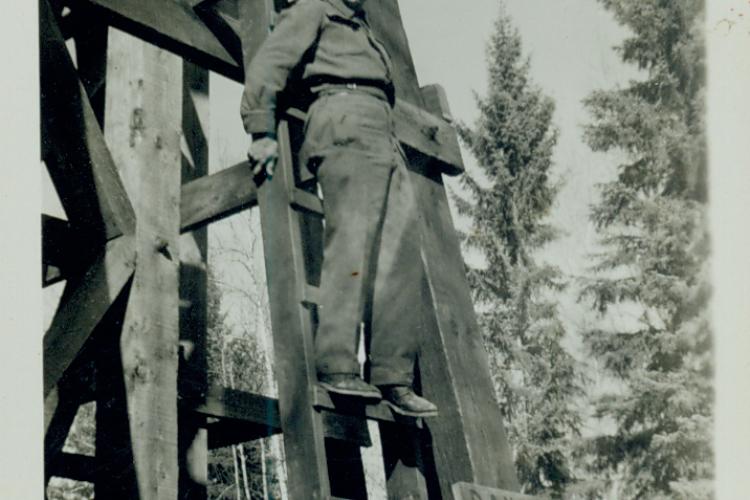Divisional Unit
SERVICE NO: A / 115918
AWARDS: 1939-45 Star, France – Germany Star,
War Medal, Canadian Volunteer Service Medal with clasp.
DATE OF BIRTH: January 28, 1922 – Zurich – County of Huron – Ontario.
DATE OF DEATH: March 5, 1945 23 years 1 month
PARENTS: Mr. Simon and Caroline Hoffman – Zurich – Ontario.
BROTHERS: Joseph, Anthony, Albert, Edgar, Leo and Wilfred – Zurich – Ontario.
SISTERS: Mrs. Rose Traher – London – Ontario.
Sister Angela Theresa “The Pines” - Chatham – Ontario.
Mary and Doreen – Zurich - Ontario
CEMETERY: Bedburg Temporary Canadian Military Cemetery – Germany.
Row 22 Grave 3
CEMETERY: Groesbeek Canadian War Cemetery – Groesbeek –
Gelderland – Netherlands.
VIII G 12
Height: 5’ 6” Weight: 144 pounds
Complexion: fair Eyes: blue Hair: blonde
Occupation: Wharehouse / Shipping at London Shoe Company.
Religion: Roman Catholic.
RESIDENCE: London
ENLISTMENT: December 30, 1942 – London – Ontario under the National Resource
Mobilization Act of 1940
ENLISTMENT AGE: 20 years 11 months
Leonard completed Grade 11 and left school at the age of 17. In approximately October of 1942. Leonard left school on the advice of a Doctor because Leonard took his studies so very seriously. The conclusion of the Doctor was that Leonard was suffering from what he called “nervous indigestion” or stress as we call it today.
There was very little recreation time in his life as he read and was learning French. There were no sports or he had no hobbies. Leonard was self conscious, timid, cautious and very close to his family and to the friend around the family farm. He was reasonably comfortable and sociable with this group.
Leonard began to attend night classes and he did this until his enlistment at the end of 1942. Following his education, he worked on the family farm near Zurich for 2 ½ years.
He then moved to London in June of 1942 and worked for the London Shoe Company located at 140 Dundas Street.
Upon his enlistment, Private Hoffman went to No. 1 NRMA Clearing Depot in London – Ontario and would be assigned there on a temporary basis.
As is the case with every soldier he has an interview with officials of the Canadian Army prior to being Taken on Strength anywhere and their conclusions of Private Hoffman were that they considered him to be very intense and serious. These Army personnel were aware of why private Hoffman had left school. They felt that he had superior learning abilities. Private Hoffman explained to them that he had hoped at some time in his life be able to study for the Roman Catholic priesthood. They also considered him studious and very hardworking. Private Hoffman felt it was his duty to serve his county and the Army felt he would do so with considerable determination. The Army suggested to Private Hoffman that he should train as a Clerk in the Royal Canadian Ordnance Corps.
- February 5, 1943 - Private Hoffman was Taken on Strength by the Oxford Rifles located in Prince George – British Columbia. On February 10, 1943, he was official attached to this unit.
- April 27, 1943 – following a medical examination Private Hoffman was deemed to be Category A1.
- May 15, 1943 – Private Hoffman complied with conditions of Canadian Army Routine Orders.
- June 4, 1943 – Private Hoffman is admitted into the Prince George Military with Bronchitis and is discharged on June 11, 1943.
- June 7, 1943 – Private Hoffman is Struck off Strength with the Oxford Rifles.
- June 11, 1943 – Private Hoffman while with the Oxford Rifles is discharged from the Natural Resource Mobilization Act while at Wainwright – Alberta.
- June 18, 1943 – Private Hoffman is appointed to the rank of Rifleman and enters the General Service.
- June 19, 1943 – Rifleman Hoffman enlists into the Canadian Active Service Force at Prince George – British Columbia.
- September 11, 1943 – Private Hoffman is granted two weeks furlough until September 24th but has accumulated 4 days leave and is allowed 7 days of travelling time meaning he is to return on October 5, 1943. Nanaimo – British Columbia.
- January 7, 1944 – Private Hoffman is granded 5 days New Years Leave
- June 19, 1944 – Private Hoffman is granted embarkation leave until July 22, 1944.
- July 2, 1944 – Private Hoffman is sent to No. 2 Transit Camp which this researcher believes was located at Debert – Nova Scotia. It was here where the men of the Canadian forces would do their final training before leaving Canada for overseas.
- August 2, 1944 – Private Hoffman departs Halifax and Canada bound for the United Kingdom.
- August 10, 1944 – Private Hoffman arrives in the United Kingdom.
- August 24, 1944 – Private Hoffman is assigned to 13th Battalion at No. 2 Canadian Base Reinforcement Group.
- August 25, 1944 – while in the United Kingdom Private Hoffman is attached to the Highland Light Infantry of Canada.
- August 25, 1944 – Private Hoffman departs the United Kingdom bound for the continent.
- August 26, 1944 – Private Hoffman arrives in France.
In the field….
August 28, 1944 – Private Hoffman joins up with his unit in the field just prior to the 3rd Canadian Infantry Division began their advance to take the port city of Boulogne.
He and the 3rd Canadian Infantry Division would battle their way through parts of France, Belgium, the Netherlands and the Battle of the Scheldt, the Battle of the Rhineland at such places as the Siegfried Line, the Calcar Ridge and finally The Hochwald.
The fight for the Hochwald was almost as large as the Normandy landings but the casualties were three times more. The Germans defended well as they knew the terrain and used it to their advantage. The Hochwald was a very heavily wooded area with a road running through the middle of it. To defeat the enemy and the terrain would lead the Canadians to the city of Xanten and the Rhine River.
The rains had started in early spring and the Canadians found themselves in water, mud and gooey mud which made advancing very difficult. In addition, there was a series of small dams within the Forest and the Germans destroyed these flooding all the farmlands. Finally, there was one road through the Forest with deep ditches in spots. The roads were cratered, they were mined, obstacles were booby trapped and the enemy had their armour and artillery very well concealed along the road and around the battlefield.
This operation was known as BLOCKBUSTER and phase I began on February 26th. Phase two advanced on February 27th and because of the fanatical resistance by the enemy the Canadians would not clear the Hochwald of the enemy for another 5 days. Then, on March 4th there was nothing but silence. The Germans had pulled back to the city of Xanten and it was here they would make their last stand.
March 5 – The Hammerbruck Feature.
In the darkness of this morning if you looked out and your eyes adjusted to the darkness you could see gentle rolling hills, fields of crops, orchards, building and patches of bush. An open field is dangerous, a nest of enemy resistance and in a few hours the scene would be a battlefield.
The Regiment would begin to advance before dawn with the support of the tanks of the Sherbrooke Fusiliers.
“A” Company would be left advance tasked with capturing three wood knolls. A” Company was right advance and were tasked with taking a piece of high ground plus a group of farm buildings. “D” Company would pass through “A” Company to take the remainder of the high feature and “B” Company for the moment was reserve.
At 2:45 am they advanced and at 3:10 am HQ learned that “C & D” had lost touch by wireless. “A” Company was pinned down by enemy machine gun fire half way to their objective. Then word came that “A” Company was firm on their objective. Another message said “C” Company pushing but they have no communications and enemy self-propelled guns are in the area.
As “A & C’” began their advance and started to spread out when “D” began to advance and this was when the firestorm began. “C” Company was pinned down from enemy fire originating from farmhouses. Tracers of light and pulsating flashes were visible and men began to fall. The tanks came up for support. They were being trapped and in moments three were burning. Shortly another four were destroyed.
If “D” was to take the high ground it would not be through “A” Company and instead they moved to the left over low ground and further was the wooded knolls that “A” was clearing. “D” moved into the low ground and they advanced through mortar fire and took some casualties. As the sky began to lighten “D” Company say a wooded knoll in front of them defended by the Germans and there was nothing but open ground between them and the enemy. To the left of “D’ Company was a wooded knoll that “A” Company had taken and they were firing on the enemy. “D” Company fixed bayonets. They were going to rush the enemy on the knoll.
Intense enemy fire was still coming from the farmhouses and a 20mm flag gun was spitting terror onto the Regiment. A platoon from “C” Company were crawling toward this position to close and eliminate this position. The eight destroyed tanks were now visible, still burning.
“D” Company with bayonets fixed had rushed the wooded knoll and had been successful in eliminating this enemy position.
“D” Company continued their advance and they were passing through a mixed pasture of trees, bushes and open ground toward another copse of trees. Here they encountered heavy enemy fire and suffered eight casualties. “D” Company called for artillery support and in a few minutes they were on their feet and continuing their advance.
Now smoke began to fall around the Regiment and it was so thick visibility was zero and the eyes and lungs began to burn and behind this was a small attacking enemy party which was eliminated by supporting artillery fire. “B” Company advanced to look for survivors.
Into the evening the fighting went on, clearing the enemy from slit trenches in the forests and scrub of the landscape.
It was during this day of battle where Private Hoffman lost his life.
- Mrs. Caroline who was the mother of Leonard had been names Executrix of his estate.
- The family was informed that as of March 5, 1945 the War Service Gratuity owed to Private Hoffman amounted to $131.72, his last pay totalled $98.77 and other credits owed him amounted to $137.74 for a sum of $368.23.
- His bank balance in the Bank of Montreal in Zurich was $135.84 and in addition he had purchased Bonds which were in the Bank of Montreal in Hensall. He also had a $1,000 insurance policy with Mutual Life.
- On April 3, 1945, a letter was written to the Hoffman family expressing regrets in the death of their family member Private Hoffman while serving his country. It went on to say that the Government of Canada pays tribute to his service. This was written by A. E. Walford per the Adjutant General.
Colonel C. L. Laurin, the Director of Records wrote a letter to the Hoffman family per the Adjutant General dated July 19, 1945 stating that Private Hoffman had been buried with all honours and rites in a temporary Canadian Military Cemetery in Germany. It also stated that at a later date, Private Hoffman would be reburied at a permanent Canadian Cemetery.
The Hoffman family received a letter from Colonel C. L. Laurin, the Director of Records per the Adjutant General dated July 23, 1946 stating that their family member Private Hoffman had been reverently reburied in Groesbeek Canadian War Cemetery. The letter also states that the family has the opportunity to send a short personal insertion which will appear on the headstone of Private Hoffman.
A letter arrived at the Hoffman home dated October 16, 1946 and enclosed was the Commander in Chief’s Certificate, which had been awarded to Leonard for his outstanding service and devotion to his country and to his duties during the North-West Europe Campaign. The letter goes on to say that the Government of Canada sends its deep regrets that Leonard did not live to receive this award in person. It was signed by Major A. C. Chadwick per the Director of Records and Adjutant General of Canada.
- The personal effects of Private Hoffman that were sent back to the Hoffman family in Canada included:2 kit bags, 1 pair socks, 1 pair woolen gloves, 2 face cloths, 1 money belt, 4 handkerchiefs, letters, 1 pair pant weights, 2 keys, 1 cloth bag, 1 mirror, 1 religious book, 1 note book, 1 toothbrush, 1 polishing cloth, 1 “I” disc, 1 pair flashes, 1 collar pin, 4 tins shoes polish, snapshots 1 pen and pencil set.



